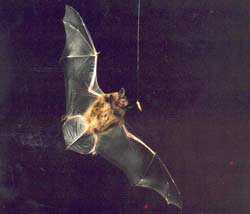 |
| A bat is targeting its prey. (Photo: LiveScience) |
When a baseball player chases after a flying ball, he maintains a constant angle between his path and the ball, following a straight line. The task of a bat is much more challenging; they must catch insects in mid-flight, while the prey is very elusive.
A recent study found that bats aim at their targets using technology similar to… guided missiles.
Bats hunt at night by emitting ultrasonic pulses from their mouths. These pulses bounce off insects and return. The entire time from detection to capture is less than one second.
The research team led by Kaushik Ghose at the University of Maryland recorded infrared videos and captured sounds of big brown bats while they were hunting insects.
The footage shows that the bat keeps its head steady towards the target, much like a baseball player fixated on the ball. However, instead of maintaining a constant angle and speed during the approach, the bat continuously alters its velocity and angle of attack. At the same time, it never takes its eyes off the prey.
“If the insect is initially located in the northwest direction, the bat will continuously maneuver to keep the target in that direction while getting closer,” Ghose said. “This strategy is known as parallel positioning. Interestingly, in the late 1940s, engineers solving the problem of how to program guided missiles to hit targets applied a similar strategy.”
A direct attack may seem much easier. But that is not the case here. The bat has to predict the location where it thinks it will catch the prey.
“It turns out that the bat’s strategy is to optimize the time it takes to catch moving targets,” Ghose said.
T. An




















































